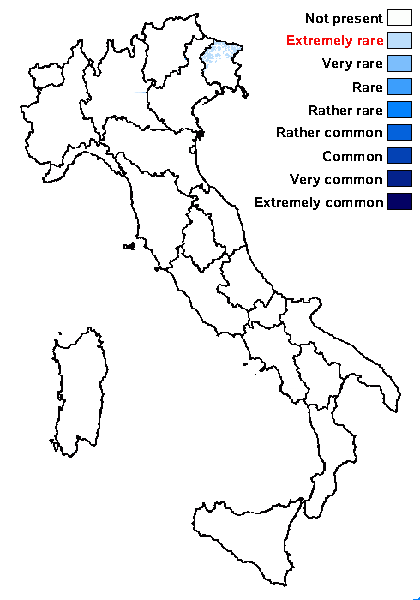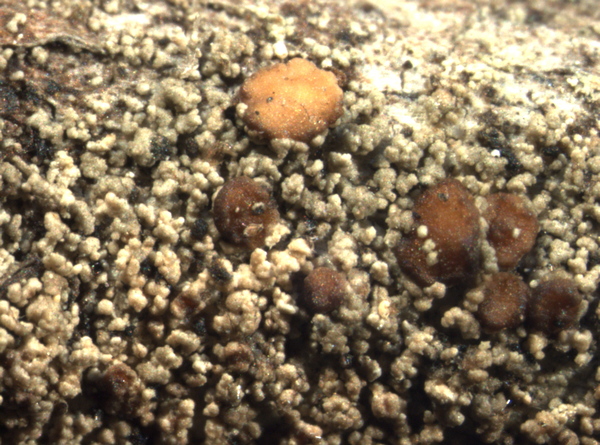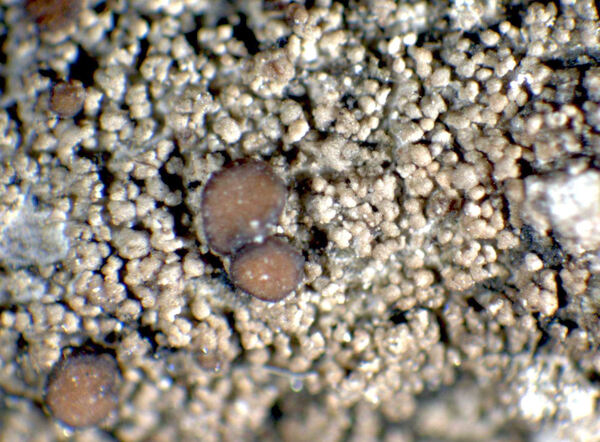Myochroidea leprosula (Arnold) Printzen, T. Sprib. & Tønsberg
Lichenologist, 40: 198, 2008. Basionym: Biatora leprosula Arnold - Lich. Exs.: 545, 1874.
Synonyms: Lecidea leprosula (Arnold) Harm.
Distribution: N - Frl (Hinteregger 1994, in Austrian terr., near the border).
Description: Thallus crustose, episubstratic, grey to grey-brown, of densely crowded, 0.05-0.15 mm wide, strongly convex, often slightly crenate to subcoralloid, isidia-like areoles. Apothecia biatorine, round to slightly irregular in outline, sessile with a constricted base or more rarely appressed, 0.3-0.8 mm across, the disc ochre, orange-brown or red-brown, flat to slightly convex, sometimes thinly whitish-pruinose (only visible when wet), the proper margin distinct, but not prominent, finally often excluded. Proper exciple brown and with minute colourless granules in outer part, colourless or pale yellow within, laterally 40-100 μm thick, of densely entangled, branched and anastomosing hyphae with slightly thickened and pigmented apical cells; epithecium to 25 μm high, pale ochre to reddish brown, with colourless to pale ochre granules which sometimes streak into the hymenium, K-, N+ bright orange-brown; hymenium colourless, 60-75 μm high; paraphyses relatively easily separated, sparingly branched and anastomosing, 0.7-1.5 μm thick, the apical cells to 2 μm wide; hypothecium colourless to yellowish, 70-150 μm high. Asci 8-spored, cylindrical-clavate, the I+ blue tholus with a wide, I+ dark blue tube structure that expands towards the top, without a pale axial body, approaching the Micarea-type. Ascospores 1-celled, hyaline, broadly ellipsoid, 9.5-15.5 x 4-8 μm. Photobiont chlorococcoid. Spot tests: thallus K-, C-, KC-, P-. Chemistry: 2 fatty acids.Note: a circumboreal species growing on twigs of subalpine shrubs, certainly more widespread in the Alps.
Growth form: Crustose
Substrata: bark
Photobiont: green algae other than Trentepohlia
Reproductive strategy: mainly sexual
Commonnes-rarity: (info)
Alpine belt: absent
Subalpine belt: extremely rare
Oromediterranean belt: absent
Montane belt: extremely rare
Submediterranean belt: absent
Padanian area: absent
Humid submediterranean belt: absent
Humid mediterranean belt: absent
Dry mediterranean belt: absent

Predictive model
Growth form: Crustose
Substrata: bark
Photobiont: green algae other than Trentepohlia
Reproductive strategy: mainly sexual
Commonnes-rarity: (info)
Alpine belt: absent
Subalpine belt: extremely rare
Oromediterranean belt: absent
Montane belt: extremely rare
Submediterranean belt: absent
Padanian area: absent
Humid submediterranean belt: absent
Humid mediterranean belt: absent
Dry mediterranean belt: absent

Predictive model
 INDEX FUNGORUM
INDEX FUNGORUM
 GBIF
GBIF
 DOLICHENS
DOLICHENS





